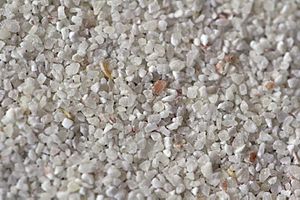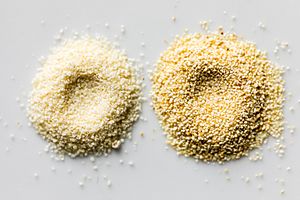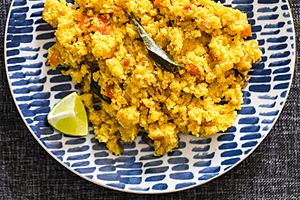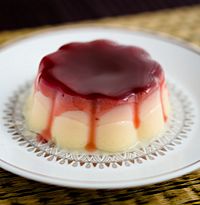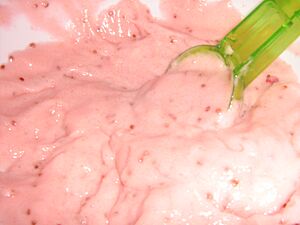Semolina facts for kids
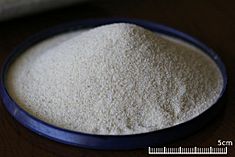 |
|
| Nutritional value per 100 g (3.5 oz) | |
|---|---|
| Energy | 1,506 kJ (360 kcal) |
|
72.83 g
|
|
| Dietary fiber | 3.9 g |
|
1.05 g
|
|
| Saturated | 0.15 g |
| Monounsaturated | 0.124 g |
| Polyunsaturated | 0.43 g |
|
Protein
|
12.68 g
|
| Vitamins | Quantity
%DV†
|
| Vitamin A equiv. |
0%
0 μg |
| Thiamine (B1) |
24%
0.28 mg |
| Riboflavin (B2) |
7%
0.08 mg |
| Niacin (B3) |
21%
3.31 mg |
| Vitamin B6 |
8%
0.1 mg |
| Folate (B9) |
18%
72 μg |
| Vitamin B12 |
0%
0 μg |
| Vitamin C |
0%
0 mg |
| Minerals | Quantity
%DV†
|
| Calcium |
2%
17 mg |
| Iron |
9%
1.23 mg |
| Magnesium |
13%
47 mg |
| Phosphorus |
19%
136 mg |
| Potassium |
6%
186 mg |
| Sodium |
0%
1 mg |
| Zinc |
11%
1.05 mg |
| Other constituents | Quantity |
| Water | 12.67 g |
| †Percentages estimated using US recommendations for adults. | |
Semolina is a special kind of flour. It is made from durum wheat, which is a very hard type of wheat. Semolina is not as fine as regular flour; it has a coarse, grainy texture. People mainly use it to make couscous, pasta, and sweet puddings.
Sometimes, the word semolina can also mean coarse flour made from other types of wheat. It can even refer to flour from other grains, like rice or corn.
Contents
What is Semolina?
Semolina comes from the Italian word semolino. This word is related to semola, which means "bran" or "flour".
How is Semolina Made?
Making semolina and flour involves a process using special steel rollers. These rollers are set very close together, just a bit narrower than a wheat grain.
When wheat goes into the mill, the rollers gently flake off the outer layer, called the bran, and the germ. The starchy inside part, called the endosperm, cracks into coarse pieces.
Next, these pieces go through a sifter. This machine separates the coarse semolina bits from the bran. The semolina can then be ground even finer to make regular flour. This method helps separate different parts of the wheat easily. It also allows mills to make different grades of flour.
Kinds of Semolina
Semolina can come from different types of wheat. This gives it different colors and textures.
Durum Wheat Semolina
Semolina made from hard durum wheat (called Triticum turgidum subsp. durum) is usually pale yellow. It can be ground coarsely or finely. Both types are used in many different sweet and savory dishes. This is the kind often used for pasta.
Here are some names for durum semolina in other languages:
- Italian: semola di grano duro
- Greek: simigdáli (σιμιγδάλι)
- Arabic: samīd (سميد)
- Turkish: irmik
Common Wheat Semolina
Semolina from softer common wheat (called Triticum aestivum) is more beige in color. It has more gluten and feels less sandy than durum semolina. In the United States, this type is often called farina. It is often used for desserts.
In India, common wheat semolina is called sooji or rava. It can be coarse or fine. People use it in many sweet and savory dishes.
Here are some names for common wheat semolina in other languages:
- Punjabi: sūjī (ਸੂਜੀ)
- Nepali: sūjī (सूजी)
- Hindustani: sūjī (सूजी/سوجی), or ravā (रवा)
- Bengali: sūjī (সুজি)
- Marathi: ravā (रवा)
- Tamil: ravai (ரவை)
Sometimes, coarse flour from other grains is also called semolina. For example, there's rice semolina and corn semolina. In the United States, corn semolina is usually called grits.
Dishes Made with Semolina
Semolina is a very versatile ingredient. It is used in many different types of food around the world.
Savory Dishes
In many European countries like Germany and Austria, semolina is mixed with egg to make Grießknödel. These are like dumplings that can be added to soups. People also cook semolina in milk and sprinkle it with chocolate for breakfast.
In Italy, fine semolina is boiled directly in vegetable or chicken broth to make a type of soup. Semolina is also used to make Gnocchi alla Romana. For this dish, semolina is mixed with milk, cheese, and butter. It is then shaped into discs and baked with cheese and bechamel sauce.
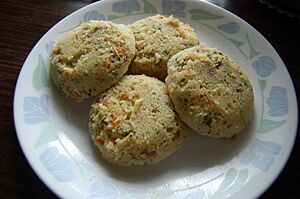
Semolina is a popular food in West Africa, especially in Nigeria. People eat it for lunch or dinner with stew or soup. It is prepared by boiling it with water for 5 to 10 minutes.
In much of North Africa, durum semolina is the main ingredient for couscous.
In India and Pakistan, semolina is called sooji or rava. It is used to make savory South Indian foods like rava dosa, rava idli, and upma. It is also used to coat fish slices before frying them.
Sweet Dishes
In the US, semolina (especially farina) is boiled to make a porridge. A well-known brand is Cream of Wheat.
In the UK, semolina is mixed with hot milk, sugar, and vanilla to make a warm pudding dessert. It used to be a common school lunch pudding.
In countries like Germany and Austria, common wheat semolina is cooked with milk and sugar. It can also be cooked without sugar and then topped with sugar, cinnamon, or other sweet toppings. This dish is called Grießbrei or semolina pudding. Sometimes, it is mixed with whipped egg whites and baked to make Grießauflauf.
A baked semolina dish called migliaccio is popular in Naples, Italy. It is a firm cake made with ricotta cheese, vanilla, citrus peel, and semolina flour.
In many countries like Sweden, Finland, and Russia, semolina is eaten as a breakfast porridge. It is sometimes mixed with raisins and served with milk. In Sweden, it is called mannagrynsgröt.
In the Middle East and North Africa, basbousa is a sweet semolina cake. It is soaked in a fragrant syrup and often topped with nuts. In North Africa, semolina is also used to make harcha, a type of griddle cake eaten for breakfast with jam or honey.
In India, semolina (Rava or Suji) is used for sweets like halwa and rava kesari. This kind of sweet is also popular in Greece (halvas) and Cyprus (halvas). In Greece, the dessert galaktoboureko is made with semolina custard wrapped in phyllo sheets. In Turkey, sweet dishes like şekerpare and şambali are made with semolina.
In Baking
Semolina can be used to dust baking surfaces. This helps prevent dough from sticking. When a small amount of durum semolina is added to regular flour for bread making, it can help create a tasty crust.
Images for kids
See also
 In Spanish: Sémola para niños
In Spanish: Sémola para niños


